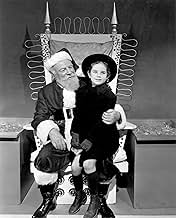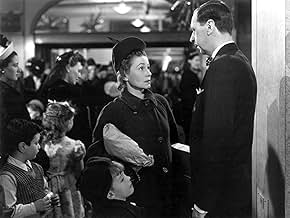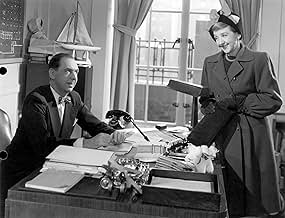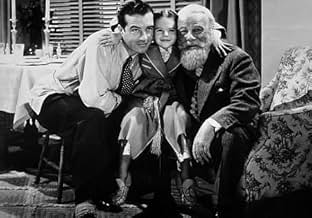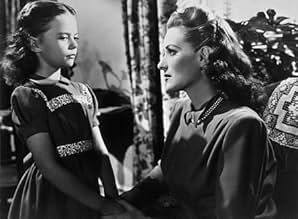अपनी भाषा में प्लॉट जोड़ेंAfter a divorced New York mother hires a nice old man to play Santa Claus at Macy's, she is startled by his claim to be the genuine article. When his sanity is questioned, a lawyer defends h... सभी पढ़ेंAfter a divorced New York mother hires a nice old man to play Santa Claus at Macy's, she is startled by his claim to be the genuine article. When his sanity is questioned, a lawyer defends him in court by arguing that he's not mistaken.After a divorced New York mother hires a nice old man to play Santa Claus at Macy's, she is startled by his claim to be the genuine article. When his sanity is questioned, a lawyer defends him in court by arguing that he's not mistaken.
- 3 ऑस्कर जीते
- 10 जीत और कुल 1 नामांकन
- Post Office Mail Sorter Next to Lou
- (बिना क्रेडिट के)
- Mr. R.H. Macy
- (बिना क्रेडिट के)
- Courtroom Spectator
- (बिना क्रेडिट के)
- Mrs. Shellhammer
- (बिना क्रेडिट के)
- Courtroom Spectator
- (बिना क्रेडिट के)
- Judge's Clerk
- (बिना क्रेडिट के)
- Child on Santa's Lap
- (बिना क्रेडिट के)
- Secretary
- (बिना क्रेडिट के)
- Department Store Head
- (बिना क्रेडिट के)
फ़ीचर्ड समीक्षाएं
I love movies like this for the insight they provide into the customs of a lost era. Watch the clothing - everybody is so dressed up! - women in dresses, gloves, and hats, men in hats and suits. Notice that when O'Hara enters a room filled with Macy's executives, even though they are the bosses and she is lower management, they all stand up instantly.
The social satire, most on display in the courtroom scenes, also is very 1940s. Apparently audiences of that era took a kind of genial corruption in the judicial system in stride. Business leaders, like "Mr. Macy" were expected to be sharp and profit-oriented, but also decent people like the rest of us. It's a much more nuanced view than the "businessman as criminal villain" so common in today's movies.
The character played by Maureen O'Hara probably needs explanation for modern viewers. Late 1940s audiences knew that the social and economic situation of a divorced working woman with a child was much more precarious than it is now. Divorce was still somewhat shocking - this is brought out neatly in the movie when her would-be lover does a double take when he learns from her daughter about the divorce - he probably had assumed she was a war widow. Divorced moms were still rare in the middle classes. Society universally agreed that women should stay home to raise their children. Economically, women in management positions were still very rare, couldn't expect promotion, and were last hired, first fired. I think O'Hara's performance brings out these qualities in a way that the audience of the 1940s would have understood easily. The character's stiffness, fear of losing control, and anxiety about her job make a great deal of sense. It would have been nice to see a few scenes showing her loosening up, perhaps at dinner with her boyfriend; no doubt those got left on the cutting room floor.
I really like the scene where Santa talks to the little Dutch orphan. First, this scene also must have resonated with the audience; in 1947 the western European countries had only started to recover from World War II, and probably many Americans were familiar with the idea of adopting a war orphan, just as many sent CARE packages. Second, by making Santa fluent in Dutch, the writer cleverly left the viewer thinking that hey, he might really be Santa Claus (isn't Santa Claus fluent in all languages)?
Some reviewers don't like the acting and think that modern actors are "better". I think the older actors aren't better or worse, just different. The audiences of the 1940s expected a certain style of acting, and the directors and actors gave that to them. Then as now, Hollywood paid top dollar and got very talented people, but like all of us they were shaped by their own time and place, more particularly the requirement to make movies that audiences would like. Move Maureen O'Hara to 2004, or Tom Cruise to 1947, and you'd see them acting in the style of that decade.
Gwenn, who played many solid character roles, gets the chance here to play a role for which he was ideally suited, and it works very well. O'Hara and Wood make a good pair to balance him out. The supporting cast gets some very good moments of their own, especially Gene Lockhart and William Frawley, whose scenes are entertaining while also offering some occasionally pointed commentary.
The style of the production is well-suited to the material, offering an innocently upbeat story without overdoing it on sentimentality. For all that this style of the production and acting are out of fashion, they are able to capture a theme like this in a worthwhile way that is simply not possible with the kind of false "sophistication" that permeates so many present-day movies.
That's not to say that this is some kind of masterpiece, which it is not and did not try to be. Instead, it's a light, enjoyable, positive movie that does make a worthwhile point or two. That kind of feature will always find an appreciative audience somewhere.
PLEASE BEWARE OF SOME REVIEWERS THAT ONLY HAVE ONLY ONE REVIEW. I HAVE OVER 400 REVIEWS OF "CHRISTMAS RELATED FILMS & SPECIALS" WHEN ITS A POSITIVE THERE IS A GOOD CHANCE THEY WERE INVOLVED WITH THE PRODUCTION. NOW I HAVE NO AGENDA! I REVIEW MOVIES & SPECIALS AS A WAY TO KEEP TRACK OF WHAT I HAVE SEEN! I HAVE DISCOVERED MANY GEMS IN MY QUEST TO SEE AS MANY " C H R I S T M A S " MOVIES AS I CAN.
Now Someone keeps reporting my reviews. I guess they are jealous because I do tell the truth. I want to point out that I never make snide remarks about actors weight or real life sexual orientation. If there acting is terrible or limited "I talk about that". If a story is bad "I will mention that" So why am I being "picked on"? IMDB? When one of my reviews gets deleted IMDB will not even tell me what someone found offensive. Well on to this review.
Kris Kringle (Edmund Gwenn) is indignant to find that the man (Percy Helton) assigned to play Santa in the annual Macy's Thanksgiving Day Parade is intoxicated. When he complains to event director Doris Walker (Maureen O'Hara), she persuades Kris to take his place. He does so well, he is hired to play Santa at Macy's flagship New York City store on 34th Street.
Ignoring instructions to steer parents to buy from Macy's, Kris directs one shopper (Thelma Ritter) to a competitor. Impressed, she tells Julian Shellhammer (Philip Tonge), head of the toy department, that she will become a loyal customer.
Attorney Fred Gailey (John Payne), Doris's neighbor, takes the young divorcée's daughter Susan (Natalie Wood) to see Santa. Doris has raised her to not believe in fairy tales, but Susan is shaken after seeing Kris speak Dutch with a girl who does not know English. Doris asks Kringle to tell Susan that he is not Santa, but he insists that he is.
Worried, Doris decides to fire him. However, Kris has generated so much positive publicity and goodwill for Macy's that Macy (Harry Antrim) promises Doris and Julian bonuses. To alleviate Doris's misgivings, Julian has Granville Sawyer (Porter Hall) administer a "psychological evaluation". Kris passes, and questions Sawyer's own mental health.
This is a great film that everyone should see.
Mrs. Walker is working, single mother, who works for Macy's Department Store in New York City. Natalie Wood plays her daughter, Susan. As the result of a failed Marriage, Doris raises her daughter to accept reality. There is no room for fantasy or make believe in her life. Susan is a quiet, child who acts more like a grown up than a 6 year old. She has difficulty using her imagination, and has become just as skeptical as her mother.
Since Kris, believes that "the important thing is to make children happy," winning the affection of Susan and her mother is his main objective.
Whether or not Kris is the real Santa Claus, there is no doubt that he seem to have an influence on almost everyone he meets--except for Macy's staff psychologist .Mr. Sawyer believes that Kris is delusional, and has him committed to thrown into a mental institution. In order to get out, Kris must face a court hearing, where not only is his sanity questioned, but the state of New York will decide if there really is a Santa Claus. Fred Gailey (played by John Payne) a neighbor of Doris Susan Walker agrees to represent Kris. The predictable end to the story is that Fred and Doris become attracted to each other, and as Fred works hard to secure Kris' freedom, Doris finds herself not only believing in Kris, but also in believing in fantasy.
Maureen O'Hara portrays Doris Walker with poise and sophistication. Although the movie is over 55 years old, the idea of a single working mom trying to raise her daughter after a bitter divorce, tells a story that is relevant by today's standards. Natalie Wood does such a good job at playing as the bright six year old, Susan, that you can almost imagine her going straight from being a baby to being an adult. John Payne, as Fred Gailey, predictably plays the handsome attorney who falls in love with Mrs. Walker. Even though it seems a bit unbelievable, this movie is all about fantasy, so we'll allow a bit of romance. Finally, Edmund Gwenn's portrayal of Santa Claus is so believable, that you almost believe that truly is the jolly old elf himself!
This reviewer would give the movie a 5 out of 5 rating. It is a Christmas classic that will be remembered for years to come as one of the best Christmas movies ever filmed. The message of the movie is not about the real meaning of Christmas, nor is it about the commercialism that has overshadowed the holiday for years. The message of the movie is that make believe and fantasy play an important role in our live. Without them we would have no basis for our hopes and dreams
क्या आपको पता है
- ट्रिवियाIn the untranslated dialogue with the Dutch girl, Kris asks her what she wants for Christmas. She says she wants nothing, telling him she got her gift by being adopted by her new mother.
- गूफ़Kris claims that John Quincy Adams' Vice-President was Daniel D. Tompkins; actually, it was John C. Calhoun. Tompkins served under James Monroe from 1817-1825. The confusion likely occurred because Adams was the 6th President, whereas Tompkins was the 6th Vice-President, as Thomas Jefferson and James Madison had three Vice-Presidents between them.
- भाव
Mr. Shellhammer: But... but maybe he's only a little crazy like painters or composers or... or some of those men in Washington.
- क्रेज़ी क्रेडिटThe film's credits do not contain the standard "All characters and events are fictional..." disclaimer, leaving many people to believe that this was a true story.
- इसके अलावा अन्य वर्जनAlso available in two computer colorized versions. The film was first colorized in 1985 by Color Systems Technology, Inc. and again in 2006 by Legend Films using much-improved technology. Prints came with a disclaimer: "It has been altered without the participation of the principal director, screenwriter and other creators of the original film."
- कनेक्शनFeatured in The Screen Writer (1950)
- साउंडट्रैकJingle Bells
(1857) (uncredited)
Written by James Pierpont
Played at the announcement of the parade
Played occasionally in the score
Sung a cappella a bit by Percy Helton and later by Jack Albertson
टॉप पसंद
- How long is Miracle on 34th Street?Alexa द्वारा संचालित
विवरण
- रिलीज़ की तारीख़
- कंट्री ऑफ़ ओरिजिन
- भाषाएं
- इस रूप में भी जाना जाता है
- De ilusión también se vive
- फ़िल्माने की जगहें
- 24 Derby Road, Port Washington, लाँग आयलैंड, न्यूयॉर्क, संयुक्त राज्य अमेरिका(Susan's dream house)
- उत्पादन कंपनी
- IMDbPro पर और कंपनी क्रेडिट देखें
बॉक्स ऑफ़िस
- दुनिया भर में सकल
- $3,851
- चलने की अवधि1 घंटा 36 मिनट
- रंग
- पक्ष अनुपात
- 1.37 : 1
इस पेज में योगदान दें







